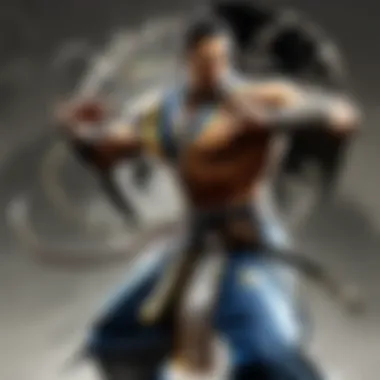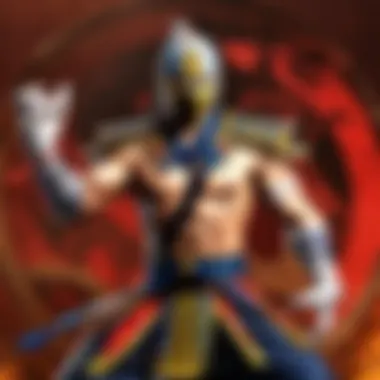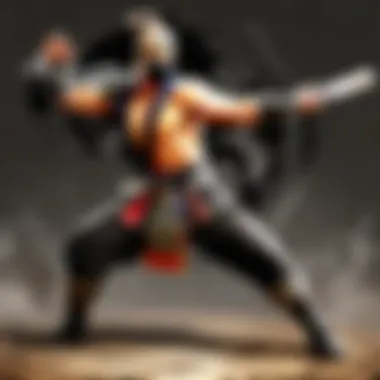Unveiling the Mastery of Wu Shu: A Complete Guide to its Artistry


Character Profiles & Movesets
In the enchanting realm of Wu Shu, the characters embody a rich tapestry of history and skill. Each fighter bears a unique background story, intricately woven with tradition and honor. Their signature moves and special abilities reflect not only their individual prowess but also the deep-rooted heritage from which they draw inspiration. Executing combos and finishing moves requires finesse and precision, honed through rigorous training and unwavering dedication.
Gameplay Strategies & Tactics
Navigating the intricate landscapes of Wu Shu demands strategic acumen and tactical prowess. Players must adapt their strategies to varying game modes and difficulty levels, leveraging different tactics to outmaneuver opponents and unleash maximum damage. Understanding the nuances of game mechanics is crucial, empowering fighters to craft personalized strategies tailored to specific matchups, mastering the art of anticipation and swift execution.
Storyline & Lore Explorations
Delving into the evocative narratives of Wu Shu unveils a tapestry of interconnected plots and rich character dynamics. The overarching storyline captivates with its depth and complexity, interwoven with compelling subplots that add layers of intrigue and suspense. Exploring character relationships offers profound insights into motivations and conflicts, while speculations on future story arcs ignite curiosity about potential crossovers, weaving a narrative tapestry of endless possibilities.
Updates & Patch Notes
Staying abreast of the latest developments in Wu Shu is essential for enthusiasts eager to explore new horizons and enhanced gameplay experiences. Comprehensive coverage of updates, patches, and DLC releases offers valuable insights into the evolving landscape of characters, stages, and gameplay dynamics. Analyzing the impact of new additions and changes provides a nuanced understanding of pre and post-patch gameplay mechanics, equipping players with the knowledge needed to adapt and excel in this ever-evolving martial arts panorama.
Introduction to Wu Shu
In embarking on the exploration of Wu Shu's profound realm, it is imperative to grasp the essence of this ancient Chinese martial art. Wu Shu, renowned for its exquisite movements and deep-rooted history, serves as a captivating subject for enthusiasts and martial arts aficionados alike. This foundational section sets the stage for a comprehensive journey through the intricacies of Wu Shu, offering insight into its origins, training methodologies, and philosophical underpinnings.
Origins of Wu Shu
Ancient Chinese Roots
Delving into the ancient Chinese roots of Wu Shu unveils a rich tapestry of tradition and legacy that have significantly shaped this martial art over centuries. The influence of historical practices and cultural heritage has laid a strong foundation for the development of Wu Shu, showcasing the resilience and timelessness of its core principles. The emphasis on discipline, respect, and mastery inherent in ancient Chinese martial arts forms the bedrock of Wu Shu, contributing to its enduring popularity and effectiveness as a means of self-cultivation.
Evolution Over Centuries
The evolution of Wu Shu over centuries reflects a dynamic fusion of innovation and preservation, bridging the gap between tradition and modernity. Through adaptations to changing societal dynamics and technological advancements, Wu Shu has evolved into a versatile discipline that accommodates a diverse range of practitioners. This evolution underscores the organic growth and adaptability of Wu Shu, ensuring its relevance and value in contemporary martial arts practice.
Philosophical Foundations
Taoist Influence
The profound influence of Taoist philosophy on Wu Shu resonates throughout its practice, emphasizing the harmony between mind, body, and spirit. By integrating Taoist principles of balance, flexibility, and inner peace, Wu Shu cultivates a holistic approach to self-mastery and personal development. The tranquil flow of movements in Wu Shu mirrors the serenity and fluidity espoused by Taoist teachings, enabling practitioners to achieve mental clarity and physical well-being.


Confucian Values
Embedded within the fabric of Wu Shu are the timeless values of Confucian ethics, guiding practitioners towards moral integrity, respect for tradition, and social responsibility. The emphasis on respect for teachers, diligence in practice, and altruism reflects the Confucian virtues upheld within Wu Shu training. These values imbue Wu Shu with a sense of ethical purpose and cultural continuity, reinforcing its significance as more than just a physical discipline.
Key Characteristics
Focus on Balance and Harmony
At the core of Wu Shu lies a meticulous focus on achieving equilibrium between opposing forces, be it in combat techniques or internal energy flow. The foundational concept of balance imparts a sense of stability and poise to practitioners, enabling them to navigate physical and emotional challenges with grace and composure. By honing their sense of balance through rigorous training, Wu Shu practitioners cultivate a harmonious synergy between body and mind, enhancing overall well-being and resilience.
Emphasis on Fluidity and Precision
The precision and fluidity exhibited in Wu Shu movements epitomize the artistry and mastery required to excel in this martial discipline. Every strike, block, and stance in Wu Shu is executed with acute precision and fluid motion, demonstrating the practitioner's mastery over body mechanics and spatial awareness. By refining techniques to achieve seamless transitions and impeccable timing, Wu Shu practitioners elevate their martial prowess to an unparalleled level of sophistication and efficacy.
Training in Wu Shu
Training in Wu Shu plays a pivotal role in this comprehensive guide, shedding light on the essential elements, benefits, and considerations pertinent to mastering this traditional Chinese martial art form. In the realm of Wu Shu, training serves as the cornerstone, providing practitioners with a platform to enhance their physical prowess, mental acuity, and spiritual depth. Through rigorous practice and discipline, individuals embarking on this journey immerse themselves in a world where precision, fluidity, and resilience converge to sculpt formidable martial artists.
Fundamental Movements
Stances and Postures
Delving into the intricate tapestry of Wu Shu's fundamental movements, one encounters a profound emphasis on stances and postures. These foundational components serve as the bedrock of a practitioner's form, fostering stability, agility, and grace. Stances and postures in Wu Shu epitomize balance and alignment, allowing practitioners to flow seamlessly from one technique to another. The meticulous cultivation of these physical fundamentals not only refines one's martial prowess but also cultivates mindfulness and presence in every movement.
Basic Strikes and Blocks
In the realm of basic strikes and blocks within Wu Shu, practitioners engage in a nuanced exploration of offensive and defensive maneuvers. Each strike and block is imbued with intention and precision, honed through dedicated practice and repetition. From agile strikes that resonate with power to strategic blocks that shield against incoming attacks, mastering these fundamental techniques is paramount in fortifying one's martial skill set. The synthesis of basic strikes and blocks epitomizes the harmonious blend of offense and defense, culminating in a dynamic and formidable martial practice.
Weapons Training
Sword Techniques
Venturing into the realm of weapons training in Wu Shu unveils the artistry and discipline embedded within sword techniques. The wielding of a sword demands not only physical dexterity but also mental acuity and emotional control. Sword techniques in Wu Shu encapsulate centuries of tradition and innovation, allowing practitioners to channel their focus, precision, and adaptability. The elegance and lethal finesse of sword techniques exemplify the fusion of grace and power, culminating in a mesmerizing display of martial proficiency.
Staff Form
Exploring the realm of staff form within Wu Shu immerses practitioners in the art of wielding this versatile weapon. The staff, known for its simplicity and effectiveness, serves as an extension of the practitioner's body, enabling fluid and dynamic movement. Staff form in Wu Shu emphasizes agility, timing, and spatial awareness, honing not only physical strength but also strategic acumen. The seamless integration of staff techniques embodies the principles of versatility and adaptability, epitomizing the multifaceted nature of weapons training in Wu Shu.


Forms and Routines
Empty-Hand Forms
Embarking on the exploration of empty-hand forms in Wu Shu unveils a synthesis of tradition, discipline, and artistic expression. Empty-hand forms encapsulate a myriad of techniques and philosophies, ranging from introspective meditation to explosive combat sequences. Practitioners engage in a visual and kinesthetic journey, weaving together intricate movements that flow with grace and purpose. The practice of empty-hand forms not only cultivates physical agility and strength but also nurtures a profound connection between mind, body, and spirit.
Weapon Forms
Exploring the realm of weapon forms in Wu Shu uncovers the rich heritage and technical prowess embodied in wielding traditional armaments. Weapon forms transcend mere physical movements, delving into the cultural significance and symbolic resonance of each weapon. From the fluid motion of a broadsword to the intricate techniques of a spear, weapon forms in Wu Shu showcase the seamless fusion of artistry and combat. Practitioners engage in a dynamic exploration of weapon forms, honing their expertise while paying homage to the historical legacy imbued within each weapon's form and function.
Masters and Pioneers
Masters and pioneers play a pivotal role in the realm of Wu Shu, embodying the essence of tradition and innovation within this ancient martial art form. They serve as revered figures, guiding disciples on the path to mastery and enlightenment. Their wisdom, skill, and dedication shape the very fabric of Wu Shu, preserving its time-honored techniques and propelling it into the modern era. By studying the lives and contributions of these masters and pioneers, one can gain profound insights into the evolution and significance of Wu Shu as both a physical discipline and a philosophical pursuit.
Notable Wu Shu Masters
Jet Li
Jet Li, a legendary figure in the world of martial arts, exemplifies the epitome of skill, discipline, and artistry. His mastery of Wu Shu techniques is unparalleled, showcasing a combination of grace, power, and precision that has captivated audiences worldwide. Jet Li's influence on Wu Shu extends beyond his exceptional physical abilities; his dedication to promoting Chinese martial arts and culture has elevated Wu Shu to international acclaim. By embodying the principles of balance, fluidity, and harmony, Jet Li has become a role model for aspiring martial artists, inspiring countless individuals to pursue excellence in both mind and body.
Yan Jie
Yan Jie, a lesser-known yet highly respected master in the Wu Shu community, brings a unique perspective and style to the art form. His emphasis on traditional techniques and philosophical depth sets him apart as a master of rare virtue. Yan Jie's commitment to preserving the spiritual core of Wu Shu, combined with his innovative approach to training, has earned him a reputation as a sage among practitioners. While not as widely recognized as some of his peers, Yan Jie's influence on the evolution of Wu Shu is profound, serving as a beacon of authenticity and wisdom in a rapidly changing world.
Historical Figures
Bodhidharma
Bodhidharma, the legendary monk credited with the initiation of martial arts at the Shaolin Temple, holds a revered status in the annals of Wu Shu history. His teachings on physical and mental discipline laid the foundation for the philosophical underpinnings of Wu Shu, emphasizing the unity of mind, body, and spirit. Bodhidharma's profound spiritual insights continue to resonate in the practice of Wu Shu, reminding practitioners of the interconnectedness of physical prowess and inner peace. His legacy endures as a symbol of transcendence and self-realization, inspiring generations of martial artists to seek enlightenment through the mastery of motion and stillness.
Chang San-feng
Chang San-feng, a legendary figure in Chinese martial arts folklore, is credited with the creation of Tai Chi Chuan, a renowned form of internal martial arts. His synthesis of Taoist principles and combat techniques birthed a new paradigm of martial arts practice, emphasizing softness, flexibility, and energy cultivation. Chang San-feng's contributions to Wu Shu reflect a deep understanding of the interconnectedness of yin and yang, movement and stillness, action and inaction. Through the practice of Tai Chi Chuan, practitioners seek harmony and balance, echoing the timeless wisdom imparted by this revered master of internal martial arts.
Wu Shu in Modern Times
Wu Shu in Modern Times holds paramount significance in this exhaustive guide as it sheds light on the contemporary landscape of this traditional Chinese martial art. In today's fast-paced world, the evolution of Wu Shu has not only preserved its core essence but has also adapted to the demands of modern society. The shift towards incorporating technology and innovation has propelled Wu Shu into a global spotlight, appealing to a diverse audience ranging from seasoned practitioners to new enthusiasts. The fusion of tradition with modernity serves as a testament to the resilience and relevance of Wu Shu in a rapidly changing world.


Competitions and Events
International Wu Shu Federation
The International Wu Shu Federation serves as a pivotal platform for promoting Wu Shu globally, fostering unity and camaraderie among practitioners worldwide. Through a series of meticulously organized events and competitions, the federation plays a significant role in standardizing training methodologies and enhancing the overall skill level of practitioners. The emphasis on cultural exchange and mutual respect underscores the federation's commitment to upholding the values of Wu Shu while embracing diversity. Participating in events hosted by the International Wu Shu Federation not only offers a competitive arena but also cultivates a sense of community and collaboration among practitioners.
World Kung Fu Championships
The World Kung Fu Championships epitomize the pinnacle of competitive Wu Shu, showcasing the highest levels of skill and artistry on a global stage. This prestigious event brings together elite practitioners from various countries, fostering a spirit of sportsmanship and excellence. The championships not only highlight individual talent but also celebrate the rich tapestry of Wu Shu styles and techniques practiced around the world. The opportunity to compete in the World Kung Fu Championships serves as a driving force for practitioners to push their limits, refine their craft, and elevate the standard of Wu Shu on a worldwide scale.
Influence on Popular Culture
Wu Shu in Films
The portrayal of Wu Shu in films has significantly contributed to popularizing this ancient martial art form, capturing the imagination of audiences globally. Through compelling storytelling and mesmerizing fight sequences, films featuring Wu Shu have propelled it into the mainstream, showcasing its beauty and power. The visual spectacle combined with intricate choreography has not only entertained viewers but also inspired a new generation of martial arts enthusiasts to explore the world of Wu Shu. The ability of films to showcase the artistry and philosophy behind Wu Shu has cemented its place in popular culture, bridging the gap between tradition and contemporary cinema.
Integration in Video Games
The integration of Wu Shu in video games has provided a unique platform for enthusiasts to immerse themselves in the captivating world of martial arts seamlessly. From showcasing authentic fighting styles to incorporating philosophical elements, video games have succeeded in translating the essence of Wu Shu into interactive experiences. This integration not only allows players to engage with the principles of Wu Shu but also offers a fun and engaging way to appreciate its complexity. The interactive nature of video games further enhances the accessibility and appeal of Wu Shu to a broader audience, fostering a deeper appreciation for this ancient art form in the digital age.
The Essence of Wu Shu
Wu Shu embodies a profound essence that transcends mere physical movements. In this in-depth exploration, we unravel the intricate layers that constitute the very core of Wu Shu. Through a meticulous dissection of its essence, we aim to shed light on the essence of this traditional Chinese martial art. The essence of Wu Shu lies in its seamless blend of grace, discipline, and history, culminating in a rich tapestry of tradition and skill. It serves as a testament to the enduring legacy of Chinese martial arts, offering practitioners a unique pathway to harmonize mind, body, and spirit.
Mind-Body Connection
Bridging Physical and Mental Well-being
The concept of bridging physical and mental well-being serves as a cornerstone of Wu Shu practice. By intertwining physical movements with mental focus, practitioners cultivate a holistic approach to self-improvement. This fusion not only enhances physical fitness but also sharpens mental acuity, fostering a harmonious connection between body and mind. The intrinsic value of this connection lies in its ability to promote overall well-being, instilling a profound sense of balance and mindfulness.
Practice of Meditation
Meditation, a key component of Wu Shu training, offers a gateway to inner tranquility and self-discovery. Through dedicated practice, individuals embark on a journey of self-exploration, delving deep into the recesses of their consciousness. The practice of meditation in Wu Shu not only hones focus and awareness but also cultivates emotional resilience and mental clarity. Its meditative aspects provide a sanctuary for contemplation and introspection, elevating the practitioner's spiritual and mental well-being.
Cultural Significance
Preserving Tradition
Preserving tradition within Wu Shu is a fundamental aspect that upholds the art's historical legacy. By honoring the ancient customs and techniques passed down through generations, practitioners pay homage to the roots of Wu Shu. This reverence for tradition not only maintains the authenticity of the art form but also fosters a deep sense of cultural pride and continuity. The preservation of tradition ensures that the essence of Wu Shu remains intact, safeguarding its heritage for future generations.
Celebrating Chinese Heritage
Celebrating Chinese heritage through Wu Shu encapsulates the spirit of national identity and pride. Rooted in Chinese culture and history, Wu Shu serves as a vibrant tapestry of the country's rich heritage and martial prowess. By showcasing traditional Chinese movements, values, and philosophies, Wu Shu becomes a cultural ambassador, offering a glimpse into the diverse tapestry of Chinese traditions. This celebration of Chinese heritage not only enriches the practice of Wu Shu but also reinforces the cultural bonds that connect past, present, and future generations.







